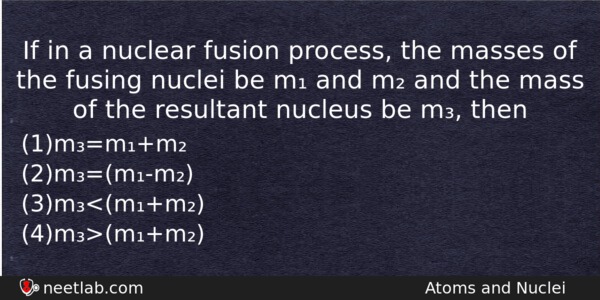| ⇦ | 
| ⇨ |
If in a nuclear fusion process, the masses of the fusing nuclei be m₁ and m₂ and the mass of the resultant nucleus be m₃, then
Options
(a) m₃=m₁+m₂
(b) m₃=(m₁-m₂)
(c) m₃<(m₁+m₂)
(d) m₃>(m₁+m₂)
Correct Answer:
m₃<(m₁+m₂)
Explanation:
(m₁+m₂) = m₃ + binding energy equivalent to mass
⇒ (m₁+m₂) > m₃
⇒ m₃<(m₁+m₂)
Related Questions: - An astronomical telescope arranged for normal adjustment has a magnification of 6.
- When a light beam of frequency v is incident on a metal surface,
- Shearing stress causes change in
- A heavy stone hanging from a massless string of length 15 m is projected
- A tyre filled with air (27° C and 2 atm) bursts. The temperature of air is (ˠ=1.5)
Topics: Atoms and Nuclei
(136)
Subject: Physics
(2479)
Important MCQs Based on Medical Entrance Examinations To Improve Your NEET Score
- An astronomical telescope arranged for normal adjustment has a magnification of 6.
- When a light beam of frequency v is incident on a metal surface,
- Shearing stress causes change in
- A heavy stone hanging from a massless string of length 15 m is projected
- A tyre filled with air (27° C and 2 atm) bursts. The temperature of air is (ˠ=1.5)
Topics: Atoms and Nuclei (136)
Subject: Physics (2479)
Important MCQs Based on Medical Entrance Examinations To Improve Your NEET Score
18000+ students are using NEETLab to improve their score. What about you?
Solve Previous Year MCQs, Mock Tests, Topicwise Practice Tests, Identify Weak Topics, Formula Flash cards and much more is available in NEETLab Android App to improve your NEET score.
Share this page with your friends

Leave a Reply